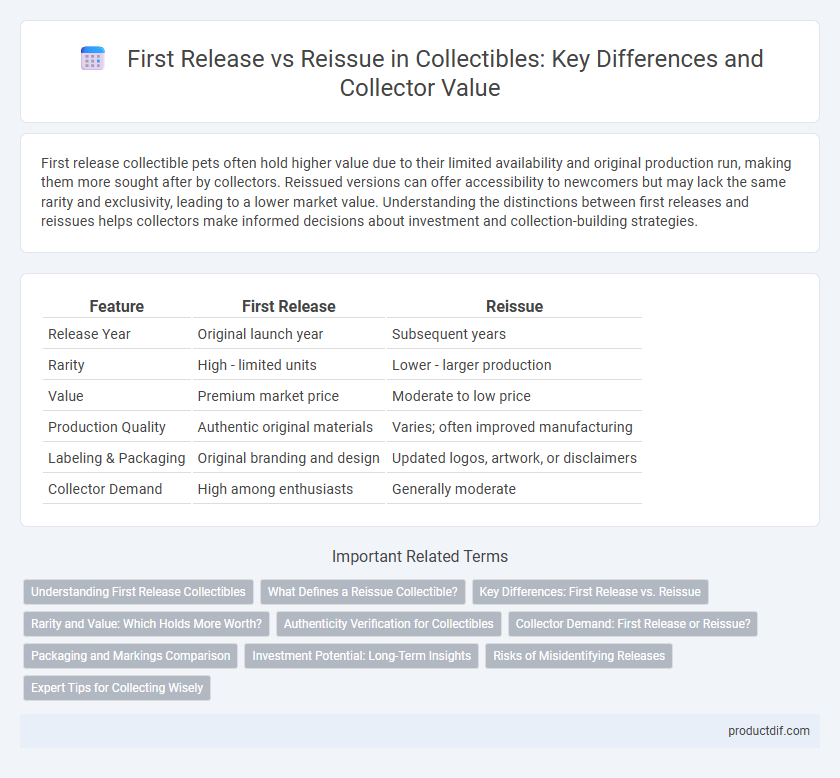First release collectible pets often hold higher value due to their limited availability and original production run, making them more sought after by collectors. Reissued versions can offer accessibility to newcomers but may lack the same rarity and exclusivity, leading to a lower market value. Understanding the distinctions between first releases and reissues helps collectors make informed decisions about investment and collection-building strategies.
Table of Comparison
| Feature | First Release | Reissue |
|---|---|---|
| Release Year | Original launch year | Subsequent years |
| Rarity | High - limited units | Lower - larger production |
| Value | Premium market price | Moderate to low price |
| Production Quality | Authentic original materials | Varies; often improved manufacturing |
| Labeling & Packaging | Original branding and design | Updated logos, artwork, or disclaimers |
| Collector Demand | High among enthusiasts | Generally moderate |
Understanding First Release Collectibles
First release collectibles hold greater value due to their originality and limited availability compared to reissue versions. Collectors prioritize first releases for their authenticity, historical significance, and potential appreciation in market price over time. Understanding the unique features and production details of first release items is crucial for accurate valuation and informed collecting decisions.
What Defines a Reissue Collectible?
A reissue collectible is defined by its reproduction of an original item, often produced years after the first release, maintaining key design elements but sometimes incorporating minor updates or additional features. These collectibles are typically marked by distinctive labels, catalog numbers, or packaging that differentiate them from first releases, aiding collectors in identification and valuation. The value of a reissue depends on rarity, condition, and how closely it replicates the original, often appealing to enthusiasts unable to obtain the initial pressing.
Key Differences: First Release vs. Reissue
First releases in collectibles represent the initial production run, often carrying higher value due to rarity and originality, while reissues are subsequent productions designed to meet demand without the same level of exclusivity. Collectors prioritize first releases for their authentic historical context and unique variations not found in reissues, which may include updated packaging or minor design changes. Market prices for first releases typically exceed those of reissues, reflecting their scarcity and significance in the collectible community.
Rarity and Value: Which Holds More Worth?
First releases typically hold greater rarity and value in the collectible market due to their limited production and original packaging, making them highly sought after by collectors. Reissues, while often more accessible, generally lack the unique characteristics and historical significance of first releases, resulting in lower market prices. Collectors prioritize authenticity and scarcity, which heavily influence the worth of first releases over reissues.
Authenticity Verification for Collectibles
Authenticity verification for collectibles relies heavily on distinguishing first releases from reissues, as first releases typically carry original markings, certificates, or serial numbers unique to their initial production. Advanced techniques such as hologram validation, UV light inspection, and blockchain authentication provide collectors with reliable evidence to confirm a collectible's provenance and legitimacy. Experts emphasize preserving original packaging and documentation when verifying authenticity, ensuring value retention and credibility in the collectible market.
Collector Demand: First Release or Reissue?
Collector demand typically favors first releases over reissues due to their original production runs, limited availability, and often higher perceived authenticity and value. First releases usually carry unique packaging, original artwork, or manufacturing details that reissues lack, enhancing their desirability among enthusiasts. However, certain reissues with improved quality or special edition features can attract niche collectors seeking specific variants.
Packaging and Markings Comparison
First release collectibles often feature original packaging materials and unique markings such as serial numbers, holograms, or exclusive logos that authenticate their edition. Reissues typically display altered packaging designs with updated text, barcodes, or disclaimers indicating their reproduction status. Comparing these elements reveals key differences in rarity and value essential for collectors assessing authenticity and investment potential.
Investment Potential: Long-Term Insights
First releases typically hold greater investment potential due to their original scarcity and historical authenticity, often appreciating significantly over time. Reissues, while more accessible, tend to maintain stable but lower value, as they lack the unique provenance of first editions. Collectors and investors prioritize first releases for long-term gains, considering factors such as limited print runs, original packaging, and production year.
Risks of Misidentifying Releases
Misidentifying first releases and reissues in collectibles can significantly impact their market value and authenticity verification. Collectors risk overpaying for reissues mistaken as original first releases, which typically hold higher rarity and demand. Careful examination of release details, such as date stamps or packaging differences, is essential to avoid costly mistakes in collectible acquisitions.
Expert Tips for Collecting Wisely
When collecting first releases, experts emphasize authenticity verification and condition preservation as crucial factors for maximizing value. Reissues often offer accessibility but generally lack the rarity that drives high market demand. Prioritizing first pressings with documented provenance ensures smarter investment and long-term appreciation in collectible markets.
First Release vs Reissue Infographic

 productdif.com
productdif.com